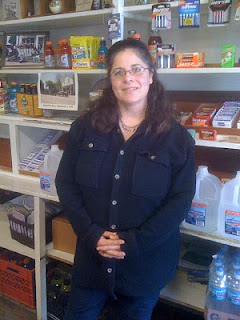
The Cooksville General Store has a record of about 165 years serving the small village of Cooksville in Rock County, Wisconsin. Most likely it is the oldest General Store operating in Wisconsin.
The General Store dates from about 1847. In that year, Charles Smith acquired from John Cook, founder of the village in 1842, a corner lot, 26 feet by 66 feet, at Main and Spring streets and built and began operating his store in the small Village of Cooksville.
In 1864, the building was sold to the second floor tenant, Waucoma Lodge No. 90. The lodge had been chartered in 1858 and had been leasing the second floor of the building. Thus begun the long association of the Masonic Lodge with the General Store.
The Masons made several improvements to the building. In 1879 shutter blinds were hung on the building’s windows, and the Masonic hall on the second floor acquired new chairs, hanging lamps, carpets, and wallpaper. In 1882 the large glass front windows were installed and new paint was applied and the “store looks very nobby,” reported the nearby Evansville newspaper at the time.
Old diaries provide details of the store’s business dealings—purchases of raisins, cream of tartar, a barrel of Spitzenberg apples, fifty pounds of flour, and delivery to the store of 19 ½ pounds of cheese—and records of luxury goods for those times such a shipment of oysters in 1872, most probably destined for an oyster supper at the Lodge (oysters were actually a frequent component of a special supper). And in June 1874 rare lemons arrived.
In 1890 the Masons bought 18 feet of land west of the building for expansion of the building, accomplished in 1894 and, as the Badger newspaper of Evansville wrote, “the room over the new part will be used as a dining room” for the Masonic Hall.
In 1893, in a jocular but nonetheless fairly accurate newspaper story, the store owner was described as a “dealer in soft and hard coal, ice cream, wood, lime, cement, perfumery, nails, putty, spectacles and tomato catsup, chocolate caramels and tar roofing, hides, tallow and maple syrup, fine gold jewelry, silverware, salt, glue, codfish and gents neckwear, full line of patent medicines, diseases of horses and children a specialty.”
The Cooksville General Store was, like most early stores, a basic dry goods, grocery and produce store. It the early days there were cracker and pickle and flour barrels, and cookies and tea in bulk tins. At times, the Cooksville Store also included fuels and building materials and hardware. Eventually, the store sold such widely assorted things as Cornish game hens, lag bolts, wash pans, clothesline, bone-meal, garden seeds, drill bits, underwear, anchovies, overshoes, lamp chimneys, paint, tobacco cloth, and kitchen utensils, as well as dairy and meat products and hot sandwiches and newspapers.
The barter system was used for many of the early years, and credit was given, even in later years, and the storekeeper functioned in some ways as a middleman for locally-grown produce.
By the mid-20th century, traveling salesman and their companies’ delivery trucks kept the rural Cooksville General Store supplied with everything on the market. That most famous of country store institutions, the” hot stove league,” weakened by many factors of modern life, such as television. was there throughout the 20th century providing written and oral communications, as well as other services for the community such as receiving and mailing packages or a place to turn to when in need of emergency assistance.
By the end of the 20th century, having been in business in the same location since 1847, the Cooksville General Store had achieved the status of the oldest operating general store in Wisconsin. At least no one has disputed the title.
# # #
[Written by Larry Reed, 2011]
















































